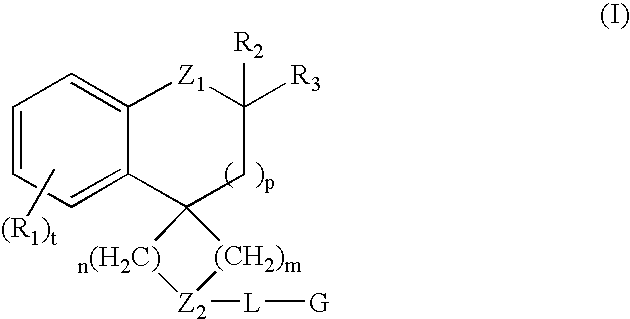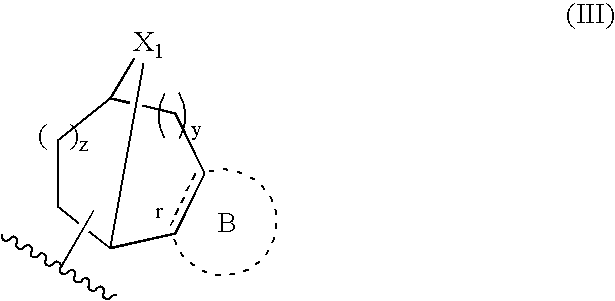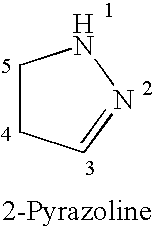Modulators of muscarinic receptors
a technology of muscarinic receptors and modulators, which is applied in the field of modulators of muscarinic receptors, can solve the problems of significant activation of the parasympathetic autonomous system, difficult to assign specific functions to individual receptors, and small progress, and achieve the effect of increasing activity and/or efficacy
- Summary
- Abstract
- Description
- Claims
- Application Information
AI Technical Summary
Benefits of technology
Problems solved by technology
Method used
Image
Examples
example 1
[0221]
[0222] To a solution of compound N-Boc Spiroindane 1a (60.0 g, 0.21 mol) in CH2Cl2 (1000 mL) was added H2O (500 mL), TBAB (6.9 g, 0.02 mol) and KOH (3.5 g, 0.06 mol) and followed by addition of KMnO4 (70.0 g, 0.45 mol) in several portions. After stirring for two days at 35° C., another quantity of KMnO4 (70.0 g, 0.45 mol) was added and the mixture was continued to stir for 2 days. After Na2SO3 (103.0 g, 1.0 mol) was added in portions at 5° C., the mixture was extracted with EtOAc. The combined organic layers were dried over anhydrous Na2SO4 and evaporated under vacuum. The residue was purified by column chromatography (PE / EtOAc: 5 / 1) to yield 1b (30.0 g, 47.7%). 1H NMR (CDCl3) δ: 7.74-7.72 (m, 1H), 7.66-7.64 (m, 1H), 7.62-7.61 (m, 1H), 7.49-7.38 (m, 1H), 4.22-4.20 (m, 2H), 2.89-2.82 (m, 2H), 2.63 (s, 2H), 2.02-1.94 (m, 2H), 1.56-1.52 (m, 2H), 1.49 (s, 9H). MS (ESI) m / z (M+H+) 246.0 / 202.1.
[0223] Boc-protected starting material 1b (400.0 mg; 1.33 mmol) was dissolved in CH2Cl2 (...
example 2
[0225]
[0226] 1.0 eq of the Boc-protected spiroindanone 2a (2.06 g, 6.84 mmol) was dissolved in anhydrous tetrahydrofuran (5 mL) and added drop-wise, under nitrogen, to an ice-cold (˜0° C.) suspension of 2.2 eq sodium hydride (600 mg, 60% dispersion in mineral oil, 15.0 mmol) in anhydrous tetrahydrofuran (10 mL). A solution of 10.0 eq iodomethane (9.71 g, 68.4 mmol) in anhydrous tetrahydrofuran (5 mL) was then added drop-wise over 20 min. The reaction was warmed to room temperature and stirred for 2 hours under nitrogen. The reaction mixture was concentrated under reduced pressure and slowly treated with H2O (25 mL). The product was extracted with ethyl acetate (2×50 mL) and the pooled extracts washed with saturated sodium bicarbonate and saturated brine, then dried (Na2SO4) and filtered. The filtrate was concentrated in vacuo to afford 2.41 g crude product 2b as a viscous, pale yellow oil. Yield=˜100%. 1H-NMR (400 MHz, acetone-d6) δ 7.90 (d, J=6.8 Hz, 1H), 7.71 (m, 2H), 7.49 (t, J=7...
example 3
[0229]
[0230] The starting Spiroindane 3a (45 mg, 0.2 mmol) was suspended in DCE (1 mL) and treated with (1S,2S,4S)-bicyclo[2.2.1]hept-5-ene-2-carbaldehyde (25 mg, 0.2 mmol) in DCE, followed by the addition of NaBH(OAc)3 (63 mg, 0.3 mmol). The reaction was allowed to stir at room temperature for 1 h and was then quenched with MeOH (0.5 mL) and allowed to stir for another 30 min (until gas evolution stopped). The crude reaction mixture was filtered, then purified by HPLC (10-99% CH3CN / 0.05% TFA gradient) to yield compound no. 312. LC / MS m / z 294.4 [M+H]+, retention time 2.33 min (RP—C18, 10-99% CH3CN / 0.05% TFA); 1H NMR (400 MHz, DMSO-d6) δ 9.33 (br s, 1H), 7.25-7.17 (m, 3H), 7.13 (d, J=6.9 Hz, 1H), 6.27-6.26 (m, 1H), 6.06-6.04 (m, 1H), 3.56-3.40 (m, 3H), 3.11-3.03 (m, 2H), 2.98-2.78 (m, 6H), 2.09-1.98 (m, 5H), 1.67 (d, J=13.9 Hz, 2H), 1.36 (t, J=8.0 Hz, 1H), 1.29 (d, J=8.2 Hz, 1H), 0.70-0.66 (m, 1H).
PUM
| Property | Measurement | Unit |
|---|---|---|
| Fraction | aaaaa | aaaaa |
| Force | aaaaa | aaaaa |
| Angle | aaaaa | aaaaa |
Abstract
Description
Claims
Application Information
 Login to View More
Login to View More - R&D
- Intellectual Property
- Life Sciences
- Materials
- Tech Scout
- Unparalleled Data Quality
- Higher Quality Content
- 60% Fewer Hallucinations
Browse by: Latest US Patents, China's latest patents, Technical Efficacy Thesaurus, Application Domain, Technology Topic, Popular Technical Reports.
© 2025 PatSnap. All rights reserved.Legal|Privacy policy|Modern Slavery Act Transparency Statement|Sitemap|About US| Contact US: help@patsnap.com



